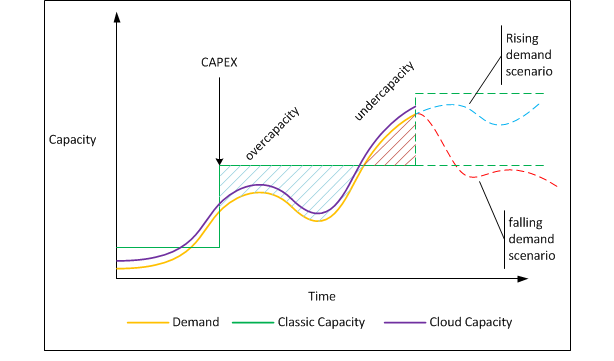Multiple variables
It is a considerable project and organizational challenge to plan and adjust the size of the IT environment for SAP systems, both when the system is planned to be implemented from scratch, and when the existing infrastructure is upgraded to S/4HANA.
It is necessary to take into account a lot of variables for which some initial conditions should be assumed, and then to make an averaged estimation of their changes in time based on the current or expected number of system users, or also on performance, e.g. a number of order lines or invoices per year, month, day. This is just a minor example from the multitude of records generated in the system. Behind them there is a more or less complicated business logic resulting from the specific nature of operation of a given organization, SAP functions, non-standard integrations, etc. This results in the high uniqueness of each project, and thus increases the uncertainty of predictions about the size of the necessary technical infrastructure.
It should also be remembered that the purchase of the necessary hardware usually has to meet the performance expectations for the next 3 years. In addition, it must be taken into account that the system load is not constant over time. It can change depending on time, days and months, and business activities (production cycles, marketing campaigns, periodical obligations resulting from legal conditions, such as tax returns and other). As early as at the implementation planning stage, it is necessary to make a reasonably accurate estimation in order to prepare IT resources for the maximum load peaks. Unfortunately, apart from such peaks, a significant part of the computing power purchased for large amounts of money remains unused.
On top of that, there are issues, often forgotten in cost calculations, related to the maintenance of IT environments, such as preparation and maintenance of your own server room, which requires for example:
- adequate physical and telecommunication protection,
- stable ambient conditions provided by air conditioning and ventilation,
- reliability of power connections and emergency power supply systems (UPS, power-generating units),
- reliability of Internet connections and fulfillment of the requirements for bandwidth and network delays,
- a reliable and efficient fire protection system.
And what if…
Or maybe to get rid of these problems and use cloud computing solutions for this purpose? They allow you to flexibly manage the capacity of computing resources, as well as to shift a part of the responsibility for maintaining selected IT infrastructure elements to the provider. What can be achieved with this? This is illustrated by the graphics below.

Use of cloud computing solutions
The green line indicates the capacity of a traditional data center, i.e. commonly speaking, a server room. Each increase of this line indicates previous capital expenditures whose planning and implementation require a relatively long time compared to changes in demand. The yellow line indicates the aggregated change in the demand for the capacity and performance of the IT infrastructure in the organization. In a situation where we use our own server room, IT hardware purchases should be planned well in advance in order to meet the demand growth in the perspective of maximum values. Large amounts of equipment for operation and maintenance may also require additional IT specialists to be employed. The purple line shows how – approximately – a cloud can solve problems with adjusting the size of IT infrastructure.
As you can see, cloud computing solutions allow you to replace capital expenditures (CAPEX) with operating expenditures (OPEX), depending on the current requirements of the organization. There is also no need to use so many IT specialists, since the cloud provider is responsible for maintaining a part of IT.
At the same time, it should be remembered that not every provider has obtained SAP certification, which confirms that the operation of the SAP system based on the SAP HANA in-memory cloud computing technology has been successfully tested. To ensure operational reliability, it is recommended to consider only those providers who meet the strict certification conditions for the SAP infrastructure.
Despite the strict requirements set by SAP, the selection is quite big. You can choose from the following solutions:
- services in a private cloud provided by the SNP (now All for one Poland) – All for One Cloud Platform
- cloud services provided by SAP (SAP HANA Enterprise Cloud, SAP HANA Cloud Platform, S/4HANA Cloud Private Option)
- public cloud services in the IaaS model (Infrastructure as a Service), e.g. Amazon Web Services (AWS), Microsoft Azure, Alibaba Cloud, Google Cloud, etc.
What is the difference between these services? Which provider to choose? It is advisable to become familiar with specific features of each of them in order to choose the solution that best meets the requirements and expectations of your organization.
Public clouds
Public cloud services in the IaaS model (Infrastructure as a Service) differ in the scope of responsibility of individual providers. Usually, however, they offer the software platform necessary to create complete virtual environments (virtual data centers) where you can run:
- virtual servers on which SAP S4/HANA solutions can be installed and maintained,
- various network components that ensure a total logical isolation of the company’s virtual data center from environments of other companies, while providing connectivity to the corporate network or via the Internet,
- hardware components, such as dedicated physical hosts (hypervisors), to ensure additional separation at the server virtualization level,
- mass storage services for storing backups of whole systems well as databases,
- other services that open up new opportunities to effectively create backup data center environments.
Public cloud services are offered as a programming platform, which provides a very high level of automation in creating and managing a virtual data center. The infrastructure can be defined as a machine code, which can be easily used, for example, to frequently set up and refresh test environments. There are multiple scenarios of using such automation possibilities. It is important to be aware of the fact that public cloud services provide many unprecedented possibilities in on-premise environments.
However, the question arises as to whether the wide range of possibilities of managing SAP environments is what the companies using SAP need.
As a rule, the basic expectation is that systems will operate reliably and efficiently on a daily basis. This requires continuous monitoring of the capacity and reliability of the IT infrastructure to prevent or respond to failures before anyone notices a problem with its operation.
Do public cloud providers provide such services? No, that is not the case. The majority of public operators only enable their technical performance. And the types of tools that will be used by companies and the extent to which they will be used are up to each company. Therefore, to make use of such services, you must have the necessary skills and knowledge on how to adapt a virtual architecture to SAP requirements, to implement and maintain it.
Even the best provider is not able to give a 100% guarantee of continuous operation of systems. And given the critical role that SAP systems play in the business continuity of an organization, surely every company wants to have a guarantee that in the event of a serious failure or disaster, the systems will be restored to operation within a specified time frame and to a specific point in time in accordance with the requirements specified by parameters, respectively RTO (Recovery Time Objective) and RPO (Recovery Point Objective).
So you need a lot of knowledge and necessary tools to set up backup solutions, to develop backup and disaster recovery plans and procedures, and to make sure they are successfully proven in test scenarios. The multitude of challenges and risks makes it necessary to employ specialists from many fields, which will generate additional costs, while responsibility for risks still remains with the organization.
To put it more clearly: despite its great potential, the public cloud does not relieve its client from challenges and administrative issues. To enjoy its advantages, you need to have a team of SAP environment management specialists or to look for support from a company with this type of skills.
Private clouds
For example, SAP HANA Enterprise Cloud (SAP HEC) is a private cloud solution in a service model called “platform as a service”, abbreviated as PaaS.
The characteristic feature of this solution is that the customer’s employees are not allowed to be involved in managing the entire SAP subordinate infrastructure, including operating systems, databases, backups, etc. Most of the software components are managed by SAP.
The detailed scope of responsibility is specified in the contract in which the scopes of services provided for a monthly fee and available for an additional fee are defined. The scope that is not covered by the monthly fee for SAP can be provided by other teams (the customer’s administrators or providers), but it does not assume the customer’s access to the layer of e.g. an operating system and a database. Each change at such a level requires a service request to be sent to SAP by an authorized person.
So we get a lot in the package, but not everything. For example, as part of the standard SAP HEC package, the following tasks have to be carried out by the customer:
- sizing of the infrastructure for SAP systems,
- setting up the monitoring of SAP systems in SAP Solution Manager,
- system performance analysis,
- recommendations of SAP system parameter changes depending on business needs,
- implementation of application notes,
- analysis of SAP errors that occur during system operation.
This means that the customer must provide administrative support for systems in the SAP HEC cloud. This can be accomplished in many ways, e.g. by building one’s own competence team, ordering this from an outsourcing company or buying additional services from SAP.
Innovative cloud computing solutions create very interesting, unprecedented possibilities of developing IT solutions that can significantly translate into new business opportunities and benefits. Therefore, it is worth considering their use in any scenario of implementing and maintaining SAP S/4HANA solutions.

Tomasz Drozdowski, System Maintenance Team Leader, All for One Poland
System administration
SNP (now All for One Poland) administers customers’ systems in both private and public clouds provided by SNP, SAP and other providers.
A company does not need to have its own team of administrators to manage its cloud-based SAP environment. The solution is SAP administration on behalf of the customer by SNP specialists, on the basis of a permanent agreement and SLA parameters. The agreement provides for continuous support in the form of environment monitoring and analysis, with a clearly defined package of technical tasks aimed at ensuring the agreed performance and availability of the system.
Depending on the needs, we may provide full administrative support (SAP administration outsourcing) or second level support (support for the customer’s SAP administrators, e.g. in solving selected problems).
Tomasz Drozdowski, System Maintenance Team Leader, All for One Poland

